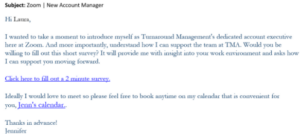The 5 Rules of Association and Vendor Partnerships
Your association, along with many others, may have been riding the reactionary behavior wave due to the pandemic. You may have been asking yourself questions such as, “What can we cut? What can we change?” and pivoted accordingly.
Knowing your association made these decisions to stay relevant, and even in some cases in existence, it is important to note that not all things that came out of the last two years of change are bad. Associations have been required to take a sharp look at their current circumstances – partner vendors included. Your vendor relationships are important and an investment for your association. Take a minute with Laura Caputo; Chief of Staff at the Turnaround Management Association and John Bacon; Vice President, Account Management to review five rules to remember as you work with your association partners now and in the future.
1. Honesty and open communication are the best policies.
John: Honesty and transparency are important in any relationship. It does not stop with your vendor partnerships. It is important for vendors to be open with their clients about successes and failures; it shows character and allows an opportunity for the client and vendor to work together to solve problems. In turn, creating a more meaningful partnership as a vendor should not only focus on “open communication,” but should also focus on what constitutes proactive communication and reactive communication. The more proactive we can be in communicating things that come up during the year, the more you are looked at as a dependable and reliable resource to your client. The only reactive communication from a vendor should be following up on requests made by the client or answering questions. Proactive communication allows you to spend more time planning and preparing for the future than mitigating emergencies.
Laura: Recently Zoom – yes, the company that saved us all during the pandemic – assigned my organization a new account manager. We received the following simple message:

The message was personalized, and it asked me to do something simple – a 2-minute survey. I could do that! So, I clicked through to take this quick survey, and not only was it easy, but it also asked a question that stood out to me.
How often would you like to meet with me to discuss your account and feature updates?
I wish all partner/vendors would ask this question. If you are anything like me, you believe your time is valuable and you do not have enough of it. I do not have time to meet with vendors and listen to pitches of products all the time, and my organization is not readily allocating budget to invest in new things throughout the year. The survey question is excellent because I can honestly reply, “Talk to me in October when we are planning our budget.” Or “Talk to me in Q1 when I plan to RFP for whatever you are offering me.” Or even, “Let’s connect every quarter because I’m ignoring your product newsletters and don’t mind talking to a human every once in a while.”
In other words, if you are a vendor partner, take the time to ask your association contacts when the right time is to communicate with them and stick to it, and association leaders, by answering honestly, you can preserve the right time in the future for these discussions.
2. A good partner should always be learning about your business.
John: It is important to take a genuine interest in your client’s success – doing your research, understanding their organizational goals and objectives, learning about their members and what they want, and so on. Finding ways to educate your client as the consultant shows that you are helping them grow their business. Being able to research trends in their industry will allow you to be proactive in solving future problems, which will help to enhance and build on current success. Any opportunity to help drive organizational goals outside of the work you do for them shows the value that you bring to the partnership. Doing a needs analysis in each client engagement ensures that we know what the focus is and allows us to help solve problems. It also allows us the opportunity to keep the organization accountable for their goals and objectives. That is true partnership!
3. Competition is fierce! Do not be surprised by customers looking elsewhere.
John: Competition is fierce, which is why it is important that you manage the client experience proactively. As a client, please be honest about your partnership with vendors. Let them know what drives success for you and if your vendor/partner is truly meeting your needs. At the same time, vendors need to constantly make sure that the work they are doing is helping their client meet their goals and if you are unsure of this, ask!
Laura: Like everyone else, my organization plans to invest in upgrading our conference room tech to better support hybrid board and team meetings this year. The account manager for our outsourced IT service provider promised that she was going to be able to help me get a quote within our budget on December 17, 2021. I wanted to have a competitive quote, so I reached out to another company on December 20, a representative from that company came to our office the next day to observe the space and provided a quote by the first week of January following our mutual holiday breaks. A month has passed since the initial conversation with my account manager, and I am still waiting for a quote. Even worse, supply chain delays mean the installation will not happen for several months, a fact which my account manager has yet to share. Competition is fierce. If you cannot provide the information, service, or product your customer needs in a timely manner, refer to Rule 1, be honest about it and keep communication open. If you do not, you should not be surprised when your customer emails asking about ending their contract.
4. Always be professional, regardless of if you have a friendly relationship with a customer’s employees.
Laura: Have you ever worked with a vendor partner that was just a little too candid? Well, you are not alone. My organization began working with one such vendor around four years ago. We were doing so much work with this vendor that we expanded their contract at the outset of 2020. Once the pandemic rolled in, we adjusted our needs accordingly but continued to work with the vendor where possible. The vendor frequently complained about our organization to individual members of our team, which they shared with other staff members. Eventually, our senior team had a meeting regarding continuing the work with this vendor, and, while one team leader carefully stated they would like to consider using another company for the work, another team leader cut in with, “At the end of the day, no one likes working with them.” If the vendor had communicated with us professionally their concerns instead of complaining to employees, we could still have been their customers. The goal is to always be honest, communicate and professional with your client.
5. Focus on being problem solvers versus forcing solutions.
John: As a partner, it is important to be problem solvers even if we do not offer a solution that meets our client’s goals. We create more value for ourselves by making sure we keep our client’s goal and objectives first. We want our client to look to us as the expert and it is our responsibility as partners to always provide a solution even if it does not match what we may want.
The pandemic gave you more questions about your bottom line than what you asked for, especially the question of whether to cut some of your most valuable partnerships with vendors. When making these decisions, the rule of thumb is to keep these five rules at hand. Be honest with open communication while focusing on solving the issue and maintaining professionalism. This will create a positive, credible relationship between you and your partner vendor.
——————————————————————-
Laura R. Caputo, Esq. Bio
 As Chief of Staff to the CEO at the Turnaround Management Association (TMA), Laura Caputo is an integral resource for the Chief Executive and Senior Team in execution of TMA’s strategic initiatives, developing processes to drive efficiency, enhance the experience of TMA’s volunteer leadership, and support the international expansion of TMA, which serves over 9,000 professionals in the corporate restructuring industry around the world.
As Chief of Staff to the CEO at the Turnaround Management Association (TMA), Laura Caputo is an integral resource for the Chief Executive and Senior Team in execution of TMA’s strategic initiatives, developing processes to drive efficiency, enhance the experience of TMA’s volunteer leadership, and support the international expansion of TMA, which serves over 9,000 professionals in the corporate restructuring industry around the world.
After a decade in private practice, Laura brought her problem-solving and critical thinking experience to the association world. Most recently, Association Forum selected Laura as a 2020 Forty Under 40 award winner. She is also proud to participate in Forum’s inaugural Latinx Advisory Group and act as Chair of its Number 2 Executives/COOs SIG. Laura has a JD from Indiana University Maurer School of Law and a BA in Advertising/Public Relations from the University of Central Florida.
John Bacon, MBA
 John Bacon is a dynamic and business-focused management professional with more than 13 years of extensive experience leading profit-generating operations for trade and professional Associations. He currently sits on the board of Directors for the Texas Society of Association Executives. His strengths include working with diverse teams and strategizing with client associations about member engagement. He also provides leadership, coaching and mentorship to a team of account managers; with the focus on helping Associations engage with their members in meaningful ways through their communication vehicles, while maximizing non-dues revenue.
John Bacon is a dynamic and business-focused management professional with more than 13 years of extensive experience leading profit-generating operations for trade and professional Associations. He currently sits on the board of Directors for the Texas Society of Association Executives. His strengths include working with diverse teams and strategizing with client associations about member engagement. He also provides leadership, coaching and mentorship to a team of account managers; with the focus on helping Associations engage with their members in meaningful ways through their communication vehicles, while maximizing non-dues revenue.

